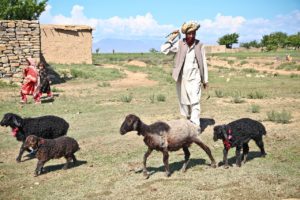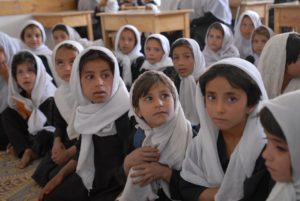 Since Relief International (RI) began working in Afghanistan in 2001, the organization has placed a major emphasis on building strong partnerships with local communities and on earning respect and acceptance in order to ensure the safety and sustainability of its work. Over the years, the scope of RI’s activities has grown considerably, but even though the organization now works in a wide range of areas—from health and education to governance and civil society—the goal of mobilizing, empowering, and supporting individual communities remains at the heart of its mission. To learn more about how RI is helping Afghan communities with both short-term relief efforts and long-term development projects, read on for an overview of four RI programs from the organization’s past and present.
Since Relief International (RI) began working in Afghanistan in 2001, the organization has placed a major emphasis on building strong partnerships with local communities and on earning respect and acceptance in order to ensure the safety and sustainability of its work. Over the years, the scope of RI’s activities has grown considerably, but even though the organization now works in a wide range of areas—from health and education to governance and civil society—the goal of mobilizing, empowering, and supporting individual communities remains at the heart of its mission. To learn more about how RI is helping Afghan communities with both short-term relief efforts and long-term development projects, read on for an overview of four RI programs from the organization’s past and present.
Improving animal health
Roughly 23 million Afghans live in rural areas, and at least three-quarters of these rely on their livestock to provide them with food and income. But after years of conflict, essentials like adequate animal feed and veterinary services are no longer readily available, thus putting not only the health of the animals at risk, but also the livelihoods of the families that depend upon them.
Together with the international rural development organization Mission d’Aide au Développement des Economies Rurales (MADERA) and supported by funding from the EU, Relief International is working in some of Afghanistan’s most vulnerable and volatile rural districts to re-establish reliable veterinary care and to educate and train farmers and livestock owners in animal husbandry best practices. By helping communities to improve shelter conditions and nutrition for their livestock, boosting the quality and availability of animal health services, and strengthening ties between public and private animal health sectors, RI is aiming to expand livestock production and increase animal productivity, which in turn have the potential to significantly improve the livelihoods of rural farmers.
Preventing zoonotic diseases
 Animal health in Afghanistan does not only affect the livelihoods of many rural families in Afghanistan, it also impacts these families’ own health. Afghanistan has a small but robust population—about 2.4 million people—of nomadic families and communities who travel with their livestock; these unique living conditions make these individuals particularly susceptible to zoonoses, which are diseases that animals and humans can transmit to each other. Zoonotic diseases pose a significant health risk, which is exacerbated by a general lack of knowledge about animal health, as well as a dearth of government support services in this area.
Animal health in Afghanistan does not only affect the livelihoods of many rural families in Afghanistan, it also impacts these families’ own health. Afghanistan has a small but robust population—about 2.4 million people—of nomadic families and communities who travel with their livestock; these unique living conditions make these individuals particularly susceptible to zoonoses, which are diseases that animals and humans can transmit to each other. Zoonotic diseases pose a significant health risk, which is exacerbated by a general lack of knowledge about animal health, as well as a dearth of government support services in this area.
Under the umbrella of its One Health Asia Program, Relief International works with Afghanistan’s ministries of health, livestock, education, and environment to develop community education and support programs for animal vaccination and zoonotic disease awareness. Educating susceptible populations enables them to better recognize early signs of infection and seek the necessary treatment, while supporting animal health care and vaccinations minimizes the threat of zoonotic disease at the source. According to officials in the Afghan government, RI is the only organization directly involved in fighting the spread of zoonotic disease.
Alleviating cold and hunger in Afghanistan’s eastern provinces
Residents of eastern Afghanistan are all too familiar with the effects of the region’s long, harsh winters: fewer jobs, higher prices for household essentials like wheat and fuel, and more precarious conditions for families who are already struggling to make ends meet.
Drawing on its strong relationships created over the years with some of Afghanistan’s most remote communities, Relief International helped support thousands of families in Kunar province through the winter of 2017 by connecting them with a cash program funded by the World Bank and Afghanistan’s Ministry of Labor, Social Affairs, Martyrs & Disabled. With RI helping direct the assistance to cases of the greatest need—typically families with children under the age of 5—the program provided financial support to nearly 2,600 families in 76 of Kunar province’s communities. As a result, more families were able to stave off childhood malnutrition and could afford to send their children to school rather than requiring them to work in order to help out the family.
School construction
 Of the many barriers to education that children and youth in Afghanistan experience, a severe shortage of proper education infrastructure is one of the biggest. With so many schools destroyed by conflict, many remaining education buildings in Afghanistan had to operate in shifts in order to be able to accommodate more students. In other cases, students had to attend classes in dilapidated or dangerous buildings, in tents, or simply in the open air: environments that are hardly conducive to learning.
Of the many barriers to education that children and youth in Afghanistan experience, a severe shortage of proper education infrastructure is one of the biggest. With so many schools destroyed by conflict, many remaining education buildings in Afghanistan had to operate in shifts in order to be able to accommodate more students. In other cases, students had to attend classes in dilapidated or dangerous buildings, in tents, or simply in the open air: environments that are hardly conducive to learning.
One of Relief International’s earliest projects in Afghanistan was the construction of three new schools in the Nijrab district of Kapisa province in the country’s northeast. Featuring 60 classrooms, the new facilities offer approximately 2,500 schoolchildren a safe and secure place to learn.
